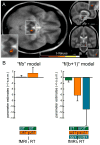Substantia nigra activity level predicts trial-to-trial adjustments in cognitive control
- PMID: 20465358
- PMCID: PMC3034980
- DOI: 10.1162/jocn.2010.21473
Substantia nigra activity level predicts trial-to-trial adjustments in cognitive control
Abstract
Effective adaptation to the demands of a changing environment requires flexible cognitive control. The medial and the lateral frontal cortices are involved in such control processes, putatively in close interplay with the BG. In particular, dopaminergic projections from the midbrain (i.e., from the substantia nigra [SN] and the ventral tegmental area) have been proposed to play a pivotal role in modulating the activity in these areas for cognitive control purposes. In that dopaminergic involvement has been strongly implicated in reinforcement learning, these ideas suggest functional links between reinforcement learning, where the outcome of actions shapes behavior over time, and cognitive control in a more general context, where no direct reward is involved. Here, we provide evidence from functional MRI in humans that activity in the SN predicts systematic subsequent trial-to-trial RT prolongations that are thought to reflect cognitive control in a stop-signal paradigm. In particular, variations in the activity level of the SN in one trial predicted the degree of RT prolongation on the subsequent trial, consistent with a modulating output signal from the SN being involved in enhancing cognitive control. This link between SN activity and subsequent behavioral adjustments lends support to theoretical accounts that propose dopaminergic control signals that shape behavior both in the presence and in the absence of direct reward. This SN-based modulatory mechanism is presumably mediated via a wider network that determines response speed in this task, including frontal and parietal control regions, along with the BG and the associated subthalamic nucleus.
Figures




References
-
- Boehler CN, Munte TF, Krebs RM, Heinze HJ, Schoenfeld MA, Hopf JM. Sensory MEG responses predict successful and failed inhibition in a stop-signal task. Cereb Cortex. 2009;19(1):134–145. - PubMed
Publication types
MeSH terms
Substances
Grants and funding
LinkOut - more resources
Full Text Sources

